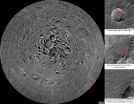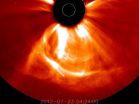(Press-News.org) PITTSBURGH, March 18, 2014 – Stem cells derived from human muscle tissue were able to repair nerve damage and restore function in an animal model of sciatic nerve injury, according to researchers at the University of Pittsburgh School of Medicine. The findings, published online today in the Journal of Clinical Investigation, suggest that cell therapy of certain nerve diseases, such as multiple sclerosis, might one day be feasible.
To date, treatments for damage to peripheral nerves, which are the nerves outside the brain and spinal cord, have not been very successful, often leaving patients with impaired muscle control and sensation, pain and decreased function, said senior author Johnny Huard, Ph.D., professor of orthopaedic surgery, and Henry J. Mankin Chair in Orthopaedic Surgery Research, Pitt School of Medicine, and deputy director for cellular therapy, McGowan Institute for Regenerative Medicine.
"This study indicates that placing adult, human muscle-derived stem cells at the site of peripheral nerve injury can help heal the lesion," Dr. Huard said. "The stem cells were able to make non-neuronal support cells to promote regeneration of the damaged nerve fiber."
The researchers, led by Dr. Huard and Mitra Lavasani, Ph.D., first author and assistant professor of orthopaedic surgery, Pitt School of Medicine, cultured human muscle-derived stem/progenitor cells in a growth medium suitable for nerve cells. They found that, with prompting from specific nerve-growth factors, the stem cells could differentiate into neurons and glial support cells, including Schwann cells that form the myelin sheath around the axons of neurons to improve conduction of nerve impulses.
In mouse studies, the researchers injected human muscle-derived stem/progenitor cells into a quarter-inch defect they surgically created in the right sciatic nerve, which controls right leg movement. Six weeks later, the nerve had fully regenerated in stem-cell treated mice, while the untreated group had limited nerve regrowth and functionality. Twelve weeks later, treated mice were able to keep their treated and untreated legs balanced at the same level while being held vertically by their tails. When the treated mice ran through a special maze, analyses of their paw prints showed eventual restoration of gait. Treated and untreated mice experienced muscle atrophy, or loss, after nerve injury, but only the stem cell-treated animals had regained normal muscle mass by 72 weeks post-surgery.
"Even 12 weeks after the injury, the regenerated sciatic nerve looked and behaved like a normal nerve," Dr. Lavasani said. "This approach has great potential for not only acute nerve injury, but also conditions of chronic damage, such as diabetic neuropathy and multiple sclerosis."
Drs. Huard and Lavasani and the team are now trying to understand how the human muscle-derived stem/progenitor cells triggered injury repair, as well as developing delivery systems, such as gels, that could hold the cells in place at larger injury sites.
INFORMATION:
Co-authors of the paper include Seth D. Thompson, B.S., Jonathan B. Pollett, Ph.D., Arvydas Usas, M.D., Aiping Lu, M.D., Donna B. Stolz, Ph.D., Katherine A. Clark, B.S., Bin Sun, Ph.D., and Bruno Péault, Ph.D., all of the University of Pittsburgh.
The project was funded by National Institutes of Health grants AR049684 and NS081724-01, the U.S. Department of Defense, the Henry J. Mankin Endowed Chair for Orthopaedic Research at the University of Pittsburgh, the William F. and Jean W. Donaldson Chair at Children's Hospital of Pittsburgh of UPMC, the Hirtzel Foundation, and the Pittsburgh Claude Pepper Older Americans Independence Center.
About the University of Pittsburgh School of Medicine
As one of the nation's leading academic centers for biomedical research, the University of Pittsburgh School of Medicine integrates advanced technology with basic science across a broad range of disciplines in a continuous quest to harness the power of new knowledge and improve the human condition. Driven mainly by the School of Medicine and its affiliates, Pitt has ranked among the top 10 recipients of funding from the National Institutes of Health since 1998. In rankings recently released by the National Science Foundation, Pitt ranked fifth among all American universities in total federal science and engineering research and development support.
Likewise, the School of Medicine is equally committed to advancing the quality and strength of its medical and graduate education programs, for which it is recognized as an innovative leader, and to training highly skilled, compassionate clinicians and creative scientists well-equipped to engage in world-class research. The School of Medicine is the academic partner of UPMC, which has collaborated with the University to raise the standard of medical excellence in Pittsburgh and to position health care as a driving force behind the region's economy. For more information about the School of Medicine, see http://www.medschool.pitt.edu.
http://www.upmc.com/media
Contact: Anita Srikameswaran
Phone: 412-578-9193
E-mail: SrikamAV@upmc.edu
Contact: Chuck Finder
Phone: 412-996-5852
E-mail: FinderCE@upmc.edu END
Stem cells from muscle can repair nerve damage after injury, Pitt researchers show
2014-03-18
ELSE PRESS RELEASES FROM THIS DATE:
Trends in food supplements differ from country to country, new study finds
2014-03-18
A new study, published today in the journal in PLOS ONE, shows which plant food supplements are most popular across Europe, with consumers using them to complement their diets or to maintain health.
The team of researchers from the Fundación para la Investigación Nutricional and the University of Surrey found that these products are taken in many different forms, including in tea, juice or by tablet. They analysed data from six European countries, collecting information from 2359 adult consumers of plant food supplements in Finland, Germany, Italy, Romania, Spain and ...
Risk of psychiatric diagnoses, medication use increases after critical illness
2014-03-18
Critically ill patients receiving mechanical ventilation had a higher prevalence of prior psychiatric diagnoses and an increased risk of a new psychiatric diagnosis and medication use after hospital discharge, according to a study in the March 19 issue of JAMA.
With recent advances in medical care, more patients are surviving critical illness. Critically ill patients are exposed to stress, including pain, respiratory distress, and delirium, all of which may impact subsequent mental health. The extent of psychiatric illness prior to critical illness, as well as the magnitude ...
Pregnancy associated with greater risk of certain bacterial infection; may worsen outcomes
2014-03-18
In a surveillance study of infection with the bacterium Haemophilus influenzae among women of reproductive age in England and Wales from 2009-2012, pregnancy was associated with a greater risk of this infection, which was associated with poor pregnancy outcomes such as premature birth and stillbirth, according to a study in the March 19 issue of JAMA.
Haemophilus influenzae can cause illnesses that include respiratory infections. Some studies have suggested an increased risk of invasive H influenzae disease during pregnancy, although these were based on a small number ...
Study examines use of age-adjusted D-dimer levels to exclude lung blood clots
2014-03-18
Using a patient's age to raise the threshold for an abnormal result of a blood test used to assess patients with a suspected pulmonary embolism (blood clot in lungs) appeared to be safe and led to fewer healthy patients with the diagnosis, according to a study in the March 19 issue of JAMA.
D-dimer is a breakdown product of a blood clot, and measuring D-dimer levels is one way doctors exclude a diagnosis of pulmonary embolism (PE). Several studies have shown that D-dimer levels increase with age. As a result, the proportion of healthy patients with abnormal test results ...
Children with glomerular kidney disease more likely to have hypertension as adults
2014-03-18
Men who as children had glomerular disease, a disorder of the portion of the kidney that filters blood and one that usually resolves with time, were more likely than men without childhood glomerular disease to have high blood pressure as an adult, according to a study in the March 19 issue of JAMA.
Glomerular disease was defined for this study as glomerulonephritis or nephrotic syndrome (both are kidney disorders). Most children who develop glomerular disease have a favorable prognosis with complete resolution of all signs and symptoms. Yet the long-term complications ...
Study finds no evidence that vitamin D supplements reduce depression
2014-03-18
NEW YORK, NY (March 18, 2014) — Vitamin D deficiency has been implicated in numerous health conditions in recent years, including depressed mood and major depressive disorder. Recent observational studies provide some support for an association of vitamin D levels with depression, but the data do not indicate whether vitamin D deficiency causes depression or vice versa. These studies also do not examine whether vitamin D supplementation improves depression.
A systematic review of clinical trials that have examined the effect of vitamin D supplementation on depression ...
JCI online ahead of print table of contents for March 18, 2014
2014-03-18
Cardiac conduction altered by intragenic enhancer
Genome-wide association studies (GWAS) have determined a surprising link between dysfunctional cardiac conduction and variants within SCN10A, which encodes nociceptor-associated sodium-gated ion channel subunit NaV1.8. Follow-up functional studies targeting NaV1.8 revealed only a minor contribution to cardiac physiology; therefore, it was unclear how SCN10A mutations promoted the development of cardiac conduction disease. In this issue of the Journal of Clinical Investigation, the research groups of Vincent Christoffels, ...
New from Geology: Fossils, earthquakes, gold, and sea-bed landslides
2014-03-18
Boulder, Colo., USA – Geology papers published 17 Mar. 2014 cover (1) modeling of seabed turbidity currents; (2) a large earthquake at Lake Vättern, Switzerland, about 11,500 years ago; (3) genesis of high-grade gold at the Porgera gold deposit, Papua New Guinea; (4) discovery of the Ediacaran guide fossil Cloudina sp. and the depositional age of the Bambuí Group; (5) earthquakes along the fossil Moho in Alpine Corsica; and (6) using LiDAR to better understand New Zealand's Alpine Fault.
Highlights are provided below. Geology articles published ahead of print can be accessed ...
NASA releases first interactive mosaic of lunar north pole
2014-03-18
Scientists, using cameras aboard NASA's Lunar Reconnaissance Orbiter (LRO), have created the largest high resolution mosaic of our moon's north polar region. The six-and-a-half feet (two-meters)-per-pixel images cover an area equal to more than one-quarter of the United States.
Web viewers can zoom in and out, and pan around an area. Constructed from 10,581 pictures, the mosaic provides enough detail to see textures and subtle shading of the lunar terrain. Consistent lighting throughout the images makes it easy to compare different regions.
"This unique image is a tremendous ...
Fierce 2012 magnetic storm barely missed Earth
2014-03-18
Earth dodged a huge magnetic bullet from the sun on July 23, 2012.
According to University of California, Berkeley, and Chinese researchers, a rapid succession of coronal mass ejections – the most intense eruptions on the sun – sent a pulse of magnetized plasma barreling into space and through Earth's orbit. Had the eruption come nine days earlier, it would have hit Earth, potentially wreaking havoc with the electrical grid, disabling satellites and GPS, and disrupting our increasingly electronic lives.
The solar bursts would have enveloped Earth in magnetic fireworks ...

